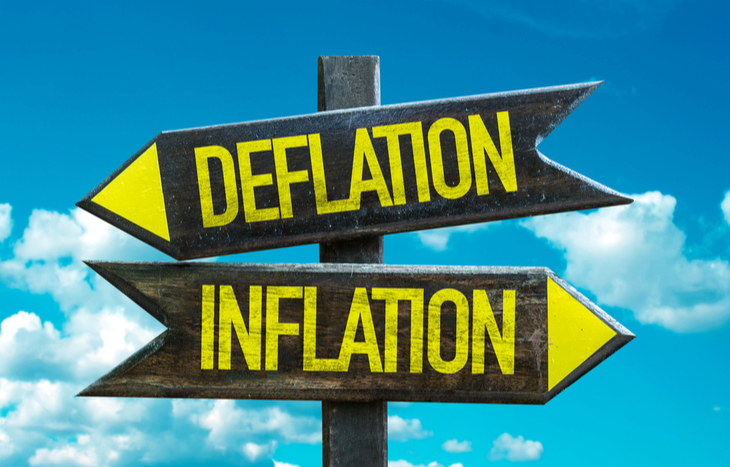What is Deflation?
Most people are familiar with the word inflation, which typically has a negative connotation. However, in economic terms, deflation is actually worse. In monetary policy, it refers to the overall shrinkage of the money supply or the decrease in the cost of goods and services. Where inflation means a rise in prices and a drop in purchasing power, deflation indicates a lack of purchasing ability altogether.
In fact, it’s a form of economic contraction. It signals a depressionary period that can lead to an economic downturn by its very nature. Thankfully, the Federal Reserve can use strategic monetary policy to avoid or combat it. Combating deflation starts by understanding it. Here’s what you need to know.

Deflation Correlates With Depression
Looking for historical examples of deflation? The best place to start is with significant stock market crashes and corrections. The Great Depression (1929-1933) was the single biggest period of deflation in United States history. The Great Recession (2007-2009) was another major deflationary period.
The correlation between deflation and depression occurs because they share catalysts. Often deflation causes economic depressions. Specifically, it’s a cyclical series of events that triggers them:
- Lower profits. Declining consumer demand causes sales and revenue to fall, which lowers the profitability of companies.
- Bankruptcy. Lower profits lead to insolvency, which forces businesses to file for bankruptcy.
- Unemployment. Bankruptcy filings come with layoffs and furloughs, which drive up the unemployment rate.
- Lower income. Unemployed individuals and households have lower incomes and thus, lack of purchasing ability beyond the essentials.
- Lower demand. Lack of buying power leads to overall decreased demand for nonessential goods and services.
This entire process perpetuates itself, which increases deflation and kickstarts economic depression. This is why it’s so dangerous, and why it’s important to recognize the economic signs and signals.
What Causes Deflation?
What starts the cycle of deflation? The answer is a number of different catalysts, but they all share a common factor: contraction. Whether it’s monetary supply or access to capital, where there’s contraction, deflation tends to follow.
- Decrease in monetary supply. When people don’t have access to money, they can’t spend it. Likewise, when businesses can’t access capital, they’re unable to grow.
- Decrease in government spending. When government spending contracts, so do all markets benchmarked against it—which is nearly every financial market.
- Decrease in business investment. Businesses that can’t access capital can’t reinvest it back into the economy, which drives down profits and productivity.
- Decrease in consumer demand. As consumer spending drops, demand drops with it, which affects profitability of companies.
Many of these catalysts are the direct result of economic depression. It can be difficult to tell where, exactly, deflation begins and what it causes (or causes it). Did a decrease in consumer demand cause companies to lay off workers, or did the layoffs cause a drop in consumer demand? Deflation illustrates the many connections and complexity of the economy.
How to Combat
Central banks are key in combating deflation. Specifically, the Fed can use monetary policy to increase spending and demand by putting more money into circulation and controlling interest rates. Some of the strategies the fed will use to prevent deflationary spiral and economic contraction include:
- Lowering bank reserves to increase monetary supply
- Quantitative easing, to exercise control over monetary supply
- Lowering target interest rates to improve access to capital
- Negative interest rates, to encourage borrowing
- Increased government spending, to improve market confidence
- Reduced tax rates, to ease financial burdens on companies and consumers
Combating deflation comes down to increasing access to cash and giving people the confidence to spend it. Depending on the cause, the Fed can pull one or many of these levers to slow and reverse the rate of deflation. Which can also prevent a recession or depression.
Deflation Isn’t Always Bad
Deflation on a macro scale is a bad sign; however, in specific cases, it isn’t necessarily bad. For example, new technology can help drive down costs, making the price of goods and services more affordable. In these situations, price deflation occurs but accessibility has gone up. And the result actually drives some expansion in the economy.
There’s no better example of positive deflation than the cost of data. In 1980, the cost of a single gigabyte of data was $437,500. Today, it’s roughly a penny. This massive deflation hasn’t killed the telecom industry—rather, it’s made it broadly accessible to more consumers and driven profitability to new heights.
How Businesses and Investors Cope
During periods of deflation, businesses need to focus on the balance sheet. That means reducing liabilities and amassing assets. A business’ biggest concern is covering its outstanding liabilities in the face of decreased sales and consumer demand. Cash reserves and minimal debt are strong positions to be in when deflation strikes.
For investors (and consumers) deflation can be an opportunity. If your personal finances aren’t affected by job loss or bankruptcy, falling prices increase your purchasing power. It’s also an opportunity to make smart investments in stable companies.
Like inflation, deflation is a tricky subject to navigate and can mean different things based on context. It’s important for businesses, investors and consumers to understand how periods of deflation affect them—and how to capitalize on the situation as monetary policy corrections begin.





